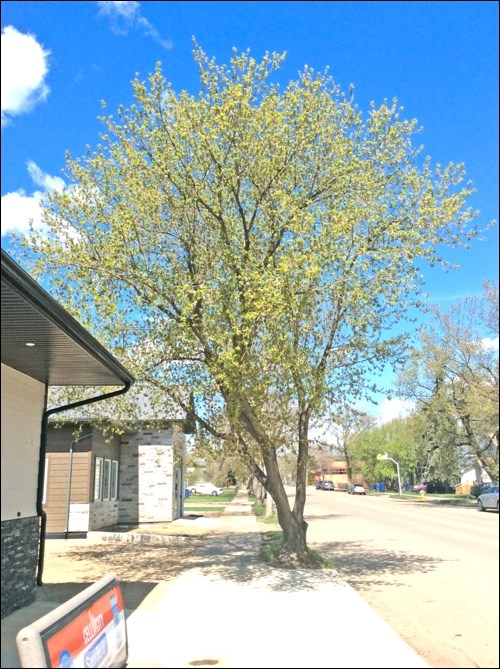A grim fate is in store for the boulevard tree in front of a new development on 101st Street.
Despite the city and council’s desire to save the Amur Maple tree, it was complicating plans to construct a driveway into the parking lot of the newly constructed building that will house the Matrix Law Group, formerly known as Holm Meiklejohn Lawrence.
The tree is located right where the entry to the parking lot was slated to go for the law firm.
City officials had believed a compromise solution could be found where the parking could be redesigned to have the parking on the south side of the lot instead of on the north side, as was previously proposed. That plan could have allowed the driveway construction to avoid the tree.
But that compromise has proved unworkable.
In a memo to City Manager Jim Puffalt from Director of Utility Services Stewart Schafer, administration officials met with partners Clifford Holm and Patricia Meiklejohn on May 17 to discuss possible configurations.
In the end, it was decided that having the parking on the south side of the parking lot area was simply too hazardous.
“Unfortunately, when we went and staked everything out it created an unsafe vehicle movement,” said Puffalt to council.
“So, unfortunately, we can’t save the tree.”
What will happen now is that the parking will be on the north side of the lot, and that means the tree has to come down to allow cars to be able to enter the lot from the street.
The property owners will be responsible for taking down the tree, and they will also be on the hook for $2,025 to cover the preliminary cost estimate, the permit cost, the tree assessment cost and the replacement and replanting cost of a new tree that will be placed in the area. The selection, planting, and placement of the new tree will be by the City of North Battleford.
Also, the property owners will foot the bill for a curb crossing and repair of the sidewalk that was also being proposed.
Puffalt also wants one more issue addressed, and that is to prevent these types of approaches onto major commercial streets in the future, particularly ones close to buildings.
“We should look to have sober thought about allowing this to happen again,” said Puffalt.
“It’s a pretty major street and you’re coming out close to a building, so I think that is a dangerous situation in itself. We should probably look to limit that.”
That issue is to be passed on to the Planning and Development department.
While the fate of a tree on 101st Street might seem trivial to local observers, the discussion was another example at City Hall of a wider issue that North Battleford and other municipalities across Canada must increasingly deal with.
That issue involves how the “urban forest” interacts with construction and new developments happening in cities and neighborhoods across the country.
Councillor Len Taylor noted the issue came up at a session of the Federation of Canadian Municipalities annual conference in Ottawa in early June. That convention was attended by North Battleford representatives including Mayor Ryan Bater.
The conference included one session that focused on the urban forest in municipalities.
Taylor said that presentation brought forward two ideas: one is a tree protocol for any new development or substantive infrastructure renovation development within cities.
“It means that on any piece of property, if trees are going to be removed, private or public, that they’re noted on that development plan,” said Taylor.
Also, if any tree could be damaged by use of heavy equipment, it would have to be marked off in a form in advance and someone would have to take responsibility for it. One idea that Saskatoon has instituted, Taylor said, was that any tree in a construction zone must have an orange fence around it to ensure equipment operators have a “visual boundary” about where to come near a tree.
The whole idea, Taylor said, is to “protect the forest infrastructure within a municipality.” He pointed to instances of new developments going up in cities without any regard for existing trees that were still in the area.
He particularly liked the idea of planning in advance. Taylor suggested taking a look at the city’s own protocol for development activity to include these ideas.
Puffalt responded this was perfect timing as a policy is already being formulated for council’s review.
“We could certainly add those things in,” said Puffalt.
Another change has already been instituted in May, and that is to put eyes on every development permit that comes in to make sure trees aren’t missed.
“It’s important that we look after our trees,” Puffalt said.




